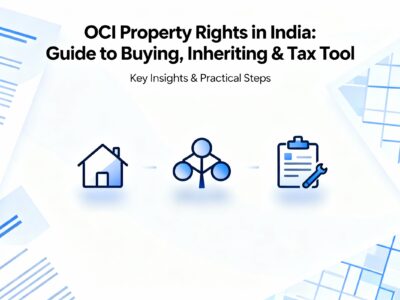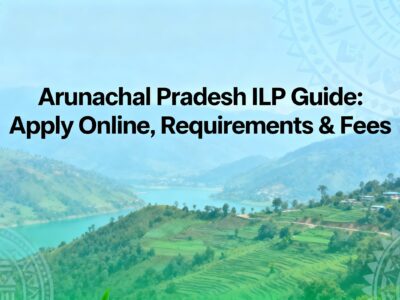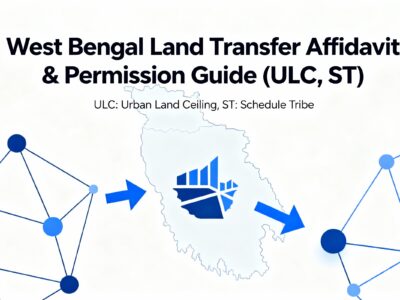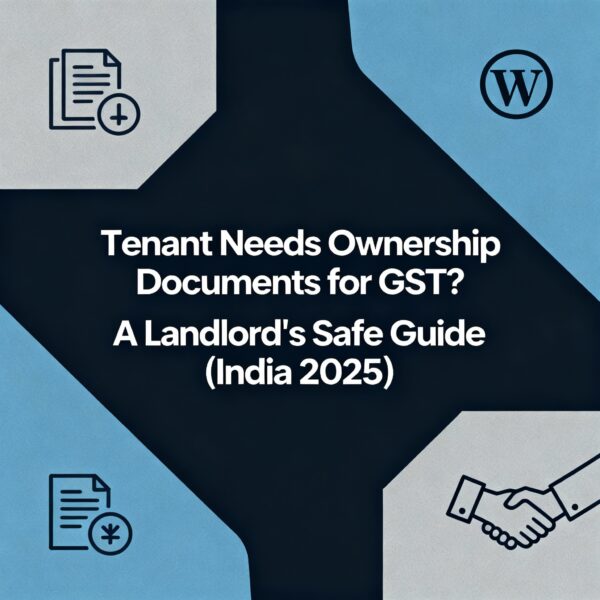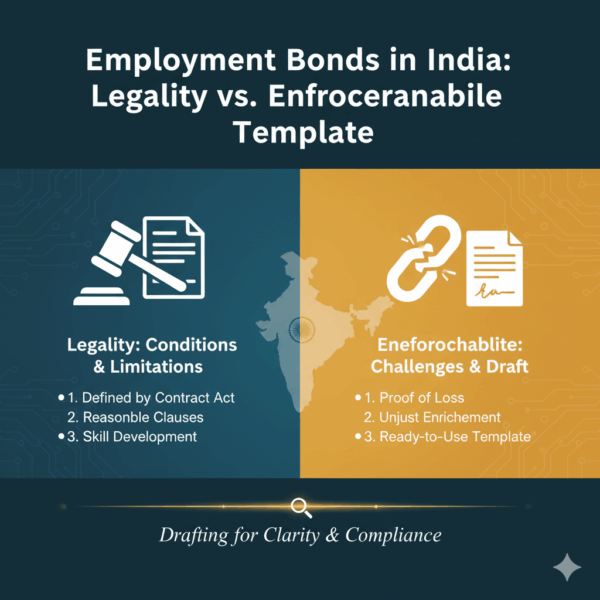Filing for divorce in India is subject to a significant “one-year bar” under Section 14 of the Hindu Marriage Act, 1955. This report provides a comprehensive legal analysis of this statute, detailing the critical exceptions of “exceptional hardship” to the petitioner and “exceptional depravity” of the respondent.
We explore the fatal procedural errors, deconstruct outdated templates, and analyze landmark case law to define what meets this high legal threshold. This guide includes multi-lingual legal formats (English, Hindi, Bengali, Tamil, Telugu) for the application and affidavit, plus an AI-assisted drafting tool to help you navigate this complex process.
The One-Year Bar: A Report on Petitions for Divorce Within One Year of Marriage
A legal analysis of Section 14 of the Hindu Marriage Act, 1955.
The Statutory Bar: Why Wait One Year?
The Hindu Marriage Act, 1955 (HMA), contains a significant restriction on seeking divorce. Section 14 of the Act states that no court can entertain a divorce petition until one year has passed since the date of the marriage.
The legislative intent behind this bar is not procedural; it's sociological. This period acts as a mandatory "cooling-off" period. The law intends to prevent hasty dissolutions of marriage based on temporary disagreements. It provides a "window for reconsideration and reconciliation," allowing couples time to resolve "temperamental differences."
However, the legislature also recognized that an inflexible rule could cause injustice in extreme cases. For this, it provided a narrow exception, or "proviso," to Section 14.
A court may allow a petition before the one-year mark, but only if the petitioner can prove one of two things:
- "Exceptional hardship" to the petitioner; or
- "Exceptional depravity" on the part of the respondent.
This sets an extremely high bar. The burden of proof is heavily on the petitioner to show that their situation is not just unhappy or difficult, but truly "exceptional."
Infographic: The Section 14 Filter
All Marriages
Couples seeking divorce
Section 14(1) Statutory Bar
Can petition only after 1 year
The Proviso (The Exception)
Exceptional Hardship OR Exceptional Depravity
The "Exceptional" Threshold: What Qualifies?
The courts have been very clear: "exceptional" does not mean "unhappy." Routine incompatibility, denial of sex, or temperamental differences are considered "ordinary" wear and tear of a marriage and do not meet the bar.
Use the filters below to see what kinds of situations courts have considered.
Denied: Mere Incompatibility
Routine arguments, behavioral differences, or falling out of love. Courts view this as the reason for the 1-year cooling-off period, not a reason to skip it.
Denied: Denial of Sex
The Delhi High Court (in Rishu Aggarwal v. Mohit Goyal) held this may be "hardship," but it is not "exceptional hardship" that justifies waiving the bar.
Granted: Aggravated Cruelty
Not just cruelty, but cruelty with "aggravating circumstances." This includes severe physical violence, life-threatening attacks, or persistent drunkenness and neglect.
Granted: Desertion in Vulnerable State
Example: A spouse is deserted in a foreign country, far from family, immediately after marriage (Harmeeta Singh v. Rajat Taneja). The totality of the vulnerability creates exceptional hardship.
Granted: "Legal Cruelty" (False FIRs)
A landmark development. If one spouse files false, serious criminal cases (e.g., Rape, POCSO) against the other, courts may see this as exceptional hardship that makes reconciliation impossible (Angad Soni v. Arpita Yadav).
Granted: Perverted or Criminal Conduct
"Depravity" focuses on the respondent's character. This could include demands for unnatural acts, promiscuous adultery (e.g., with multiple partners or family members), or involvement in serious criminal enterprises.
Illustrative Success Rate of Section 14 Applications
This chart illustrates the high bar. Most applications are denied for failing to meet the "exceptional" standard or for procedural errors.
Landmark Cases: A Comparison
| Case | Court / Year | Grounds Alleged | Finding | Key Rationale |
|---|---|---|---|---|
| Rishu Aggarwal v. Mohit Goyal | Delhi HC, 2022 | Denial of sex, temperamental differences. | Leave Denied | This is "hardship," but not "exceptional hardship" as required by the statute. |
| Angad Soni v. Arpita Yadav | Allahabad HC, 2025 | Filing of false FIRs for Rape (Sec 376) & POCSO. | Leave Granted | Such acts constitute exceptional hardship/depravity and make reconciliation impossible, rendering the 1-year bar purposeless. |
| Harmeeta Singh v. Rajat Taneja | Delhi HC, 2003 | Desertion in the US within months of marriage. | Leave Granted | The totality of circumstances (immediacy, foreign country, vulnerability) created exceptional hardship. |
Procedure is Everything: A Common & Fatal Mistake
You cannot simply file a divorce petition and ask for the bar to be waived. Failure to follow the exact procedure is the most common reason for dismissal. You must file a separate application asking for permission *first*.
DO: The Correct Procedure
-
1.
Draft THREE documents:
(a) The main Divorce Petition,
(b) A separate "Application for Leave" (I.A.),
(c) An "Affidavit in Support" of the I.A. - 2. File all three documents together.
- 3. The Court will first hear arguments only on the "Application for Leave."
- 4. If leave is granted, the main divorce petition is registered and proceeds.
DON'T: The 1982 Template's Mistake
- 1. Draft only a main Divorce Petition and a supporting affidavit (like the old 1982 template).
- 2. File these two documents.
- 3. The court dismisses the entire petition as non-maintainable because...
- 4. Fatal Error: You failed to file the mandatory "Application for Leave" under Sec 14(1), which is what gives the court jurisdiction to hear the case at all.
Case Study: Deconstructing the 1982 Affidavit Template
The 1982 template affidavit provides a valuable lesson in how drafting has evolved. While its *intent* was correct (to show hardship), its *procedure and style* are now dangerously outdated.
Analysis of the 1982 Template
Procedural Flaw: Merged Documents
The 1982 template acts as both an affidavit *and* the main application. It's a single document. As shown in our "Correct Procedure" infographic, this is a fatal error. Modern practice requires a separate "Application for Leave" (I.A.) *and* a separate "Affidavit in Support." Filing the 1982-style document today would likely lead to immediate dismissal.
Content Flaw: Vague Allegations
The template mentions "abusing me in the most coarse and insulting language" and "beating with his fists and cane." By today's standards, this is too vague. A modern affidavit would require:
• Dates: *When* did this happen?
• Specifics: *What* was said?
• Evidence: Was there a medical report? A police complaint?
The Takeaway
Never rely on outdated templates. Legal procedure is strict. The 1982 template fails because it doesn't follow the mandatory two-step process (Application + Affidavit) and its allegations lack the specificity and corroborating evidence required by courts today.
The Court's Other Considerations (Section 14(2))
Even if you prove exceptional hardship, the court's job isn't over. Section 14(2) of the HMA imposes two more duties on the judge when deciding whether to grant leave:
1. Probability of Reconciliation
The court must consider if there is any "reasonable probability of a reconciliation between the parties." If the court feels reconciliation is still possible, it will deny the application and force the parties to wait for the one-year "cooling-off" period. This is why cases involving false *criminal* complaints (like Angad Soni) are often successful, as such an act demonstrates that reconciliation is truly impossible.
2. Interests of any Children
The statute explicitly commands the court to have "regard to the interests of any children of the marriage." The presence of children, especially very young ones, can make the court more hesitant to grant leave. The court will weigh the exceptional hardship to the petitioner against the potential harm and disruption to the children. Conversely, the 1982 template's statement (Para 11: "That there is no living children") strengthens a petitioner's application, as it removes this consideration.
Legal Formats (Multi-lingual)
Disclaimer: The following templates are for informational purposes only. It is strongly advised to consult a qualified legal professional for drafting official documents.
Template 1: Application for Leave (I.A.)
IN THE COURT OF THE PRINCIPAL JUDGE, FAMILY COURT AT [CITY] APPLICATION NO. _____ OF 20__ (In the matter of) H.M.A. PETITION NO. _____ OF 20__ IN THE MATTER OF: Smt. A ... APPLICANT / PETITIONER VERSUS Shri B ... OPPOSITE PARTY / RESPONDENT APPLICATION UNDER THE PROVISO TO SECTION 14(1) OF THE HINDU MARRIAGE ACT, 1955 MOST RESPECTFULLY SHEWETH: 1. That the Applicant/Petitioner has filed the accompanying petition for divorce under Section [13(1)(ia)] of the HMA. 2. That the marriage was solemnized on [Date of Marriage]. 3. That the present application and petition are being filed on [Date of Filing], which is before the expiration of one year. 4. That the proviso to Section 14(1) empowers this Court to grant leave in cases of "exceptional hardship" or "exceptional depravity". 5. That the facts detailed in the accompanying Affidavit in Support constitute clear exceptional hardship and depravity. 6. That (Briefly state the ground, e.g., extreme physical violence, false criminal cases, etc.). 7. That given the Respondent's conduct, there is no reasonable probability of reconciliation. (Ref: Sec 14(2)) 8. That there are no children from the marriage. (Ref: Sec 14(2)) 9. That this application is supported by an affidavit. PRAYER It is, therefore, most respectfully prayed that this Hon'ble Court may be pleased to: (a) Grant leave to the Applicant/Petitioner to present the accompanying petition for divorce; (b) Take the accompanying petition on record and issue notice; (c) Pass any other order(s) as deemed fit. APPLICANT / PETITIONER THROUGH (ADVOCATE)
Template 2: Affidavit in Support of Application
IN THE COURT OF THE PRINCIPAL JUDGE, FAMILY COURT
AT [CITY]
AFFIDAVIT
(In support of Application No. ____ of 20__)
IN THE MATTER OF:
Smt. A ... APPLICANT / PETITIONER / DEPONENT
VERSUS
Shri B ... OPPOSITE PARTY / RESPONDENT
I, Smt. A, [Age, Address], do hereby solemnly affirm and state:
1. That I am the Applicant/Petitioner and competent to swear this affidavit.
2. That I am filing this affidavit in support of my Application for Leave under Sec 14(1) HMA.
3. That my marriage was solemnized on [Date of Marriage] at [Place].
4. That there are no living children of the marriage.
5. That the facts justifying my plea of exceptional hardship are as follows:
5(a). That on [Date], the Respondent... (Detail the specific act of violence, cruelty, or depravity).
5(b). That on [Date], the Respondent... (Detail another specific act).
5(c). (Be specific, chronological, and detailed. This is your evidence).
5(d). (e.g., That on [Date], the Respondent filed false FIR No. ... under Sec 376 IPC, causing me exceptional hardship...).
6. That I have annexed copies of [e.g., Medical Reports, FIR, photographs] as Annexure A-1, A-2, etc.
7. That due to the aforesaid conduct, there is no reasonable probability of reconciliation.
DEPONENT
VERIFICATION
Verified at [Place] on [Date] that the contents of paragraphs 1 to 7 are true to my personal knowledge.
DEPONENT
अस्वीकरण (Disclaimer): निम्नलिखित प्रारूप केवल सूचनात्मक उद्देश्यों के लिए हैं। आधिकारिक दस्तावेज़ों का मसौदा तैयार करने के लिए एक योग्य कानूनी पेशेवर से परामर्श करने की दृढ़ता से सलाह दी जाती है।
प्रारूप 1: अवकाश के लिए आवेदन (आई.ए.)
प्रधान न्यायाधीश, परिवार न्यायालय, [शहर] के न्यायालय में आवेदन संख्या _____ सन् 20__ (के मामले में) एच.एम.ए. याचिका संख्या _____ सन् 20__ के मामले में: श्रीमती ए ... आवेदक / याचिकाकर्ता बनाम श्री बी ... विरोधी पक्ष / प्रतिवादी हिंदू विवाह अधिनियम, 1955 की धारा 14(1) के परंतुक के तहत आवेदन अत्यंत सम्मानपूर्वक निवेदन है: 1. यह कि आवेदक/याचिकाकर्ता ने एच.एम.ए. की धारा [13(1)(ia)] के तहत तलाक के लिए संलग्न याचिका दायर की है। 2. यह कि विवाह [विवाह की तारीख] को संपन्न हुआ था। 3. यह कि वर्तमान आवेदन और याचिका [दाखिल करने की तारीख] को दायर की जा रही है, जो एक वर्ष की समाप्ति से पहले है। 4. यह कि धारा 14(1) का परंतुक इस न्यायालय को "असाधारण कठिनाई" या "असाधारण भ्रष्टता" के मामलों में अवकाश प्रदान करने का अधिकार देता है। 5. यह कि संलग्न शपथ पत्र में विस्तृत तथ्य स्पष्ट रूप से असाधारण कठिनाई और भ्रष्टता का गठन करते हैं। 6. यह कि (संक्षेप में आधार बताएं, उदा., अत्यधिक शारीरिक हिंसा, झूठे आपराधिक मामले, आदि)। 7. यह कि प्रतिवादी के आचरण को देखते हुए, सुलह की कोई उचित संभावना नहीं है। (संदर्भ: धारा 14(2)) 8. यह कि विवाह से कोई संतान नहीं है। (संदर्भ: धारा 14(2)) 9. यह कि यह आवेदन एक शपथ पत्र द्वारा समर्थित है। प्रार्थना अतः, यह अत्यंत सम्मानपूर्वक प्रार्थना की जाती है कि यह माननीय न्यायालय कृपया: (क) आवेदक/याचिकाकर्ता को तलाक के लिए संलग्न याचिका प्रस्तुत करने की अनुमति प्रदान करे; (ख) संलग्न याचिका को रिकॉर्ड पर ले और नोटिस जारी करे; (ग) कोई अन्य आदेश पारित करे जो उचित समझा जाए। आवेदक / याचिकाकर्ता द्वारा (अधिवक्ता)
प्रारूप 2: आवेदन के समर्थन में शपथ पत्र
प्रधान न्यायाधीश, परिवार न्यायालय,
[शहर] के न्यायालय में
शपथ पत्र
(आवेदन संख्या ____ सन् 20__ के समर्थन में)
के मामले में:
श्रीमती ए ... आवेदक / याचिकाकर्ता / शपथकर्ता
बनाम
श्री बी ... विरोधी पक्ष / प्रतिवादी
मैं, श्रीमती ए, [आयु, पता], एतद्द्वारा सत्यनिष्ठा से पुष्टि करती हूं और बयान करती हूं:
1. यह कि मैं उपरोक्त मामले में आवेदक/याचिकाकर्ता हूं और यह शपथ पत्र देने के लिए सक्षम हूं।
2. यह कि मैं यह शपथ पत्र एच.एम.ए. की धारा 14(1) के तहत अपने अवकाश के आवेदन के समर्थन में दायर कर रही हूं।
3. यह कि मेरा विवाह [विवाह की तारीख] को [स्थान] पर संपन्न हुआ था।
4. यह कि विवाह से कोई जीवित संतान नहीं है।
5. यह कि मेरी असाधारण कठिनाई की दलील को सही ठहराने वाले तथ्य इस प्रकार हैं:
5(क). यह कि [तारीख] को, प्रतिवादी ने... (हिंसा, क्रूरता, या भ्रष्टता के विशिष्ट कार्य का विवरण दें)।
5(ख). यह कि [तारीख] को, प्रतिवादी ने... (एक और विशिष्ट कार्य का विवरण दें)।
5(ग). (विशिष्ट, कालानुक्रमिक और विस्तृत रहें। यह आपका सबूत है)।
5(घ). (उदा., यह कि [तारीख] को, प्रतिवादी ने झूठी एफआईआर संख्या ... धारा 376 आईपीसी के तहत दायर की, जिससे मुझे असाधारण कठिनाई हुई...)।
6. यह कि मैंने [उदा., मेडिकल रिपोर्ट, एफआईआर, तस्वीरें] की प्रतियां अनुलग्नक ए-1, ए-2, आदि के रूप में संलग्न की हैं।
7. यह कि उपरोक्त आचरण के कारण, सुलह की कोई उचित संभावना नहीं है।
शपथकर्ता
सत्यापन
[स्थान] पर आज [तारीख] को सत्यापित किया कि पैराग्राफ 1 से 7 की सामग्री मेरी व्यक्तिगत जानकारी के अनुसार सत्य है।
शपथकर्ता
দাবিত্যাগ (Disclaimer): নিম্নলিখিত টেমপ্লেটগুলি শুধুমাত্র তথ্যগত উদ্দেশ্যে। অফিসিয়াল নথি খসড়া করার জন্য একজন যোগ্য আইনী পেশাদারের সাথে পরামর্শ করার জন্য দৃঢ়ভাবে সুপারিশ করা হচ্ছে।
টেমপ্লেট ১: ছুটির জন্য আবেদন (আই.এ.)
মাননীয় প্রধান বিচারপতি, পারিবারিক আদালত, [শহর]-এর আদালতে আবেদন নং _____ সন 20__ (এর বিষয়ে) এইচ.এম.এ. পিটিশন নং _____ সন 20__ এর বিষয়ে: শ্রীমতী এ ... আবেদনকারী / আবেদনকারী বনাম শ্রী বি ... প্রতিপক্ষ / উত্তরবাদী হিন্দু বিবাহ আইন, 1955-এর ধারা 14(1)-এর বিধান অনুসারে আবেদন সবিনয় নিবেদন এই যে: ১. আবেদনকারী/পিটিশনার এইচ.এম.এ.-এর ধারা [13(1)(ia)]-এর অধীনে বিবাহবিচ্ছেদের জন্য সহগামী পিটিশন দাখিল করেছেন। ২. বিবাহ [বিবাহের তারিখ]-এ সম্পন্ন হয়েছিল। ৩. বর্তমান আবেদন ও পিটিশন [দাখিলের তারিখ]-এ দাখিল করা হচ্ছে, যা এক বছর মেয়াদ শেষ হওয়ার আগে। ৪. ধারা 14(1)-এর বিধান এই আদালতকে "অসামান্য কষ্ট" বা "অসামান্য অধঃপতন"-এর ক্ষেত্রে ছুটি মঞ্জুর করার ক্ষমতা দেয়। ৫. সহগামী হলফনামায় বর্ণিত তথ্যগুলি স্পষ্টতই অসামান্য কষ্ট এবং অধঃপতনের প্রমাণ। ৬. (সংক্ষেপে ভিত্তি উল্লেখ করুন, যেমন, চরম শারীরিক সহিংসতা, মিথ্যা ফৌজদারি মামলা, ইত্যাদি)। ৭. উত্তরবাদীর আচরণের পরিপ্রেক্ষিতে, পুনর্মিলনের কোনও যুক্তিসঙ্গত সম্ভাবনা নেই। (সূত্র: ধারা 14(2)) ৮. বিবাহ থেকে কোনও সন্তান নেই। (সূত্র: ধারা 14(2)) ৯. এই আবেদনটি একটি হলফনামা দ্বারা সমর্থিত। প্রার্থনা অতএব, সবিনয় প্রার্থনা করা হচ্ছে যে এই মাননীয় আদালত অনুগ্রহ করে: (ক) আবেদনকারী/পিটিশনারকে বিবাহবিচ্ছেদের জন্য সহগামী পিটিশন দাখিল করার অনুমতি দিন; (খ) সহগামী পিটিশনটি রেকর্ডে গ্রহণ করুন এবং নোটিশ জারি করুন; (গ) অন্য যে কোনও আদেশ দিন যা উপযুক্ত বলে মনে করা হয়। আবেদনকারী / পিটিশনার মাধ্যমে (আইনজীবী)
টেমপ্লেট ২: আবেদনের সমর্থনে হলফনামা
মাননীয় প্রধান বিচারপতি, পারিবারিক আদালত,
[শহর]-এর আদালতে
হলফনামা
(আবেদন নং ____ সন 20__-এর সমর্থনে)
এর বিষয়ে:
শ্রীমতী এ ... আবেদনকারী / পিটিশনার / হলফকারী
বনাম
শ্রী বি ... প্রতিপক্ষ / উত্তরবাদী
আমি, শ্রীমতী এ, [বয়স, ঠিকানা], এতদ্বারা সদাসত্যে ঘোষণা করছি এবং বলছি যে:
১. আমি এই মামলার আবেদনকারী/পিটিশনার এবং এই হলফনামা দেওয়ার জন্য সক্ষম।
২. আমি এইচ.এম.এ.-এর ধারা 14(1)-এর অধীনে আমার ছুটির আবেদনের সমর্থনে এই হলফনামা দাখিল করছি।
৩. আমার বিবাহ [বিবাহের তারিখ]-এ [স্থান]-এ সম্পন্ন হয়েছিল।
৪. বিবাহ থেকে কোনও জীবিত সন্তান নেই।
৫. আমার অসামান্য কষ্টের আবেদনকে সমর্থনকারী তথ্যগুলি নিম্নরূপ:
৫(ক). [তারিখ]-এ, উত্তরবাদী... (সহিংসতা, নিষ্ঠুরতা বা অধঃপতনের নির্দিষ্ট ঘটনার বিবরণ দিন)।
৫(খ). [তারিখ]-এ, উত্তরবাদী... (আরেকটি নির্দিষ্ট ঘটনার বিবরণ দিন)।
৫(গ). (নির্দিষ্ট, কালানুক্রমিক এবং বিস্তারিত হন। এটি আপনার প্রমাণ)।
৫(ঘ). (যেমন, [তারিখ]-এ, উত্তরবাদী আমার বিরুদ্ধে মিথ্যা এফআইআর নং ... ধারা 376 আইপিসি-তে দায়ের করেছেন, যা আমার অসামান্য কষ্টের কারণ হয়েছে...)।
৬. আমি [যেমন, মেডিকেল রিপোর্ট, এফআইআর, ছবি]-এর কপি অ্যানেক্সার এ-1, এ-2, ইত্যাদি হিসাবে সংযুক্ত করেছি।
৭. উপরোক্ত আচরণের কারণে, পুনর্মিলনের কোনও যুক্তিসঙ্গত সম্ভাবনা নেই।
হলফকারী
সত্যাপন
[স্থান]-এ আজ [তারিখ]-এ যাচাই করা হলো যে 1 থেকে 7 নং অনুচ্ছেদের বিষয়বস্তু আমার ব্যক্তিগত জ্ঞান অনুসারে সত্য।
হলফকারী
பொறுப்புத் துறப்பு (Disclaimer): பின்வரும் வார்ப்புருக்கள் தகவல் நோக்கங்களுக்காக மட்டுமே. அதிகாரப்பூர்ভ ஆவணங்களைத் தயாரிப்பதற்கு ஒரு தகுதி வாய்ந்த சட்ட நிபுணரை அணுகுவது dringendப் பரிந்துரைக்கப்படுகிறது.
வார்ப்புரு 1: விடுப்புக்கான விண்ணப்பம் (I.A.)
முதன்மை நீதிபதி, குடும்ப நல நீதிமன்றம், [நகரம்] நீதிமன்றத்தில் விண்ணப்ப எண் _____ 20__ (வழக்கு) H.M.A. மனு எண் _____ 20__ வழக்கு: திருமதி A ... விண்ணப்பதாரர் / மனுதாரர் எதிர் திரு B ... எதிர் தரப்பினர் / பிரதிவாதி இந்து திருமணச் சட்டம், 1955, பிரிவு 14(1) இன் கீழ் விண்ணப்பம் மிகுந்த மரியாதையுடன் சமர்ப்பிக்கப்படுகிறது: 1. விண்ணப்பதாரர்/மனுதாரர், இந்து திருமணச் சட்டத்தின் பிரிவு [13(1)(ia)]-ன் கீழ் விவாகரத்து கோரி இத்துடன் இணைக்கப்பட்டுள்ள மனுவைத் தாக்கல் செய்துள்ளார். 2. திருமணம் [திருமணத் தேதி] அன்று நடைபெற்றது. 3. இந்த விண்ணப்பமும் மனுவும் [தாக்கல் செய்யும் தேதி] அன்று தாக்கல் செய்யப்படுகின்றன, இது ஒரு வருடம் முடிவதற்குள் ஆகும். 4. பிரிவு 14(1)-ன் நிபந்தனை, "விதிவிலக்கான கஷ்டம்" அல்லது "விதிவிலக்கான சீரழிவு" போன்ற சந்தர்ப்பங்களில் விடுப்பு வழங்க இந்த நீதிமன்றத்திற்கு அதிகாரம் அளிக்கிறது. 5. இத்துடன் இணைக்கப்பட்டுள்ள பிரமாணப் பத்திரத்தில் விவரிக்கப்பட்டுள்ள உண்மைகள், தெளிவான விதிவிலக்கான கஷ்டம் மற்றும் சீரழிவைக் காட்டுகின்றன. 6. (சுருக்கமாக காரணத்தைக் குறிப்பிடவும், எ.கா., கடுமையான உடல் ரீதியான வன்முறை, பொய் கிரிமினல் வழக்குகள் போன்றவை). 7. பிரதிவாதியின் நடத்தை காரணமாக, சமரசத்திற்கு எந்தவொரு நியாயமான வாய்ப்பும் இல்லை. (பார்வை: பிரிவு 14(2)) 8. திருமணத்தின் மூலம் குழந்தைகள் எவரும் இல்லை. (பார்வை: பிரிவு 14(2)) 9. இந்த விண்ணப்பம் ஒரு பிரமாணப் பத்திரத்தால் ஆதரிக்கப்படுகிறது. பிரார்த்தனை எனவே, மாண்புமிகு நீதிமன்றம் பின்வருவனவற்றைச் செய்யுமாறு மிகவும் தாழ்மையுடன் பிரார்த்திக்கப்படுகிறது: (அ) விண்ணப்பதாரர்/மனுதாரர் விவாகரத்துக்கான இனை மனுவைத் தாக்கல் செய்ய விடுப்பு வழங்குதல்; (ஆ) இனை மனுவைப் பதிவில் ஏற்று, அறிவிப்பு அனுப்புதல்; (இ) பொருத்தமானதாகக் கருதும் வேறு ஏதேனும் உத்தரவுகளைப் பிறப்பித்தல். விண்ணப்பதாரர் / மனுதாரர் வழியாக (வழக்கறிஞர்)
வார்ப்புரு 2: விண்ணப்பத்தை ஆதரிக்கும் பிரமாணப் பத்திரம்
முதன்மை நீதிபதி, குடும்ப நல நீதிமன்றம்,
[நகரம்] நீதிமன்றத்தில்
பிரமாணப் பத்திரம்
(விண்ணப்ப எண் ____ 20__ இன் ஆதரவாக)
வழக்கு:
திருமதி A ... விண்ணப்பதாரர் / மனுதாரர் / பிரமாணதாரர்
எதிர்
திரு B ... எதிர் தரப்பினர் / பிரதிவாதி
நான், திருமதி A, [வயது, முகவரி], பின்வருமாறு மனப்பூர்வமாக உறுதிமொழி அளிக்கிறேன்:
1. நான் மேற்கண்ட வழக்கில் விண்ணப்பதாரர்/மனுதாரர் என்பதாலும், கீழே கூறப்பட்டுள்ள உண்மைகளை நன்கு அறிந்தவன் என்பதாலும் இந்த பிரமாணப் பத்திரத்தைத் தாக்கல் செய்ய தகுதி உடையவன்.
2. நான் இந்த பிரமாணப் பத்திரத்தை H.M.A. பிரிவு 14(1)-ன் கீழ் எனது விடுப்பு விண்ணப்பத்தின் ஆதரவாக தாக்கல் செய்கிறேன்.
3. எனது திருமணம் [திருமணத் தேதி] அன்று [இடம்] என்ற இடத்தில் நடைபெற்றது.
4. திருமணத்தின் மூலம் உயிருடன் குழந்தைகள் எவரும் இல்லை.
5. எனது விதிவிலக்கான கஷ்டத்திற்கான வாதத்தை நியாயப்படுத்தும் உண்மைகள் பின்வருமாறு:
5(அ). [தேதி] அன்று, பிரதிவாதி... (வன்முறை, கொடுமை அல்லது சீரழிவின் குறிப்பிட்ட செயலை விவரிக்கவும்).
5(ஆ). [தேதி] அன்று, பிரதிவாதி... (மற்றொரு குறிப்பிட்ட செயலை விவரிக்கவும்).
5(இ). (குறிப்பாக, காலவரிசைப்படி மற்றும் விரிவாகக் குறிப்பிடவும். இது உங்கள் சான்றாகும்).
5(ஈ). (எ.கா., [தே தேதி] அன்று, பிரதிவாதி என் மீது பொய் FIR எண் ... பிரிவு 376 IPC-ன் கீழ் தாக்கல் செய்தார், இது எனக்கு விதிவிலக்கான கஷ்டத்தை ஏற்படுத்தியது...).
6. நான் [எ.கா., மருத்துவ அறிக்கைகள், FIR, புகைப்படங்கள்]-இன் நகல்களை இணைப்பு A-1, A-2 என இணைத்துள்ளேன்.
7. மேற்கூறிய நடத்தை காரணமாக, சமரசத்திற்கு எந்தவொரு நியாயமான வாய்ப்பும் இல்லை.
பிரமாணதாரர்
சரிபார்ப்பு
[இடம்] என்ற இடத்தில் [தேதி] அன்று, பத்தி 1 முதல் 7 வரையிலான உள்ளடக்கங்கள் எனது தனிப்பட்ட அறிவுக்கு எட்டியவரை உண்மையானவை என சரிபார்க்கப்பட்டது.
பிரமாணதாரர்
నిరాకరణ (Disclaimer): కింది టెంప్లేట్లు సమాచార ప్రయోజనాల కోసం మాత్రమే. అధికారిక పత్రాలను రూపొందించడానికి అర్హత కలిగిన న్యాయ నిపుణుడిని సంప్రదించడం గట్టిగా సిఫార్సు చేయబడింది.
నమూనా 1: అనుమతి కోసం దరఖాస్తు (I.A.)
ప్రిన్సిపల్ జడ్జి, కుటుంబ న్యాయస్థానం, [నగరం] కోర్టులో దరఖాస్తు సంఖ్య _____ 20__ (సంగతిలో) H.M.A. పిటిషన్ సంఖ్య _____ 20__ సంగతిలో: శ్రీమతి A ... దరఖాస్తుదారు / పిటిషనర్ వర్సెస్ శ్రీ B ... ఎదుటి పక్షం / ప్రతివాది హిందూ వివాహ చట్టం, 1955, సెక్షన్ 14(1) ప్రొవిసో కింద దరఖాస్తు అత్యంత గౌరవపూర్వకంగా విన్నవించునది: 1. దరఖాస్తుదారు/పిటిషనర్ H.M.A. సెక్షన్ [13(1)(ia)] కింద విడాకుల కోసం జతపరచిన పిటిషన్ను దాఖలు చేశారు. 2. వివాహం [వివాహ తేదీ] నాడు జరిగింది. 3. ప్రస్తుత దరఖాస్తు మరియు పిటిషన్ [దాఖలు చేసిన తేదీ] నాడు దాఖలు చేయబడుతున్నాయి, ఇది ఒక సంవత్సరం గడువు ముగియక ముందే. 4. సెక్షన్ 14(1) ప్రొవిసో "అసాధారణమైన కష్టం" లేదా "అసాధారణమైన దుర్మార్గం" సందర్భాలలో అనుమతి మంజూరు చేయడానికి ఈ కోర్టుకు అధికారం ఇస్తుంది. 5. జతపరచిన అఫిడవిట్లో వివరించిన వాస్తవాలు స్పష్టమైన అసాధారణమైన కష్టం మరియు దుర్మార్గంను సూచిస్తున్నాయి. 6. (క్లుప్తంగా ఆధారాన్ని పేర్కొనండి, ఉదా., తీవ్రమైన శారీరక హింస, తప్పుడు క్రిమినల్ కేసులు మొదలైనవి). 7. ప్రతివాది ప్రవర్తన దృష్ట్యా, రాజీకి ఎటువంటి సహేతుకమైన అవకాశం లేదు. (సూచన: సెక్షన్ 14(2)) 8. వివాహం నుండి పిల్లలు ఎవరూ లేరు. (సూచన: సెక్షన్ 14(2)) 9. ఈ దరఖాస్తు ఒక అఫిడవిట్ ద్వారా మద్దతు ఇవ్వబడింది. ప్రార్థన అందువల్ల, ఈ గౌరవనీయ న్యాయస్థానాన్ని అత్యంత గౌరవపూర్వకంగా ప్రార్థిస్తున్నాము: (ఎ) దరఖాస్తుదారు/పిటిషనర్కు విడాకుల కోసం జతపరచిన పిటిషన్ను సమర్పించడానికి అనుమతి మంజూరు చేయాలి; (బి) జతపరచిన పిటిషన్ను రికార్డులోకి తీసుకుని, నోటీసు జారీ చేయాలి; (సి) తగినట్లుగా భావించే ఇతర ఉత్తర్వు(ల)ను జారీ చేయాలి. దరఖాస్తుదారు / పిటిషనర్ ద్వారా (న్యాయవాది)
నమూనా 2: దరఖాస్తుకు మద్దతుగా అఫిడవిట్
ప్రిన్సిపల్ జడ్జి, కుటుంబ న్యాయస్థానం,
[నగరం] కోర్టులో
అఫిడవిట్
(దరఖాస్తు సంఖ్య ____ 20__ కు మద్దతుగా)
సంగతిలో:
శ్రీమతి A ... దరఖాస్తుదారు / పిటిషNER / అఫిడవిట్ దాఖలుదారు
వర్సెస్
శ్రీ B ... ఎదుటి పక్షం / ప్రతివాది
నేను, శ్రీమతి A, [వయస్సు, చిరునామా], ఇందుమూలముగా గంభీరంగా ధృవీకరించి, తెలియజేయునది:
1. నేను పై కేసులో దరఖాస్తుదారు/పిటిషనర్ను మరియు ఈ అఫిడవిట్ దాఖలు చేయడానికి అర్హుడను.
2. నేను H.M.A. సెక్షన్ 14(1) కింద నా అనుమతి దరఖాస్తుకు మద్దతుగా ఈ అఫిడవిట్ను దాఖలు చేస్తున్నాను.
3. నా వివాహం [వివాహ తేదీ] నాడు [స్థలం] వద్ద జరిగింది.
4. వివాహం నుండి జీవించి ఉన్న పిల్లలు ఎవరూ లేరు.
5. నా అసాధారణమైన కష్టాన్ని సమర్థించే వాస్తవాలు క్రింది విధంగా ఉన్నాయి:
5(ఎ). [తేదీ] నాడు, ప్రతివాది... (హింస, క్రూరత్వం లేదా దుర్మార్గం యొక్క నిర్దిష్ట చర్యను వివరించండి).
5(బి). [తేదీ] నాడు, ప్రతివాది... (మరొక నిర్దిష్ట చర్యను వివరించండి).
5(సి). (నిర్దిష్టంగా, కాలక్రమానుసారంగా మరియు వివరంగా ఉండండి. ఇది మీ సాక్ష్యం).
5(డి). (ఉదా., [తేదీ] నాడు, ప్రతివాది నాపై తప్పుడు FIR నం. ... సెక్షన్ 376 IPC కింద దాఖలు చేశారు, ఇది నాకు అసాధారణమైన కష్టాన్ని కలిగించింది...).
6. నేను [ఉదా., మెడికల్ రిపోర్టులు, FIR, ఫోటోగ్రాఫ్లు] కాపీలను అనెక్జర్ A-1, A-2, మొదలైనవిగా జతపరిచాను.
7. పైన పేర్కొన్న ప్రవర్తన కారణంగా, రాజీకి ఎటువంటి సహేతుకమైన అవకాశం లేదు.
అఫిడవిట్ దాఖలుదారు
ధృవీకరణ
[స్థలం] వద్ద [తేదీ] నాడు, పేరా 1 నుండి 7 వరకు ఉన్న విషయాలు నా వ్యక్తిగత పరిజ్ఞానం మేరకు నిజమని ధృవీకరిస్తున్నాను.
అఫిడవిట్ దాఖలుదారు
Affidavit Drafting: A Deep Dive
The affidavit is the single most important document in your application. It is your primary evidence. Vague allegations are worthless; specificity is everything.
DO: Be a Factual Reporter
- Use Specific Dates & Times: "On October 25, 2025, at 10:00 PM..." is powerful. "He often came home drunk" is weak.
- Quote Directly (if possible): "He threatened me, saying 'I will ruin your life'" is stronger than "he threatened me."
- Be Chronological: Tell the story from the beginning. Build a narrative of escalating hardship or depravity.
- Refer to Evidence: "I filed FIR No. 123/2025, a copy of which is Annexure A-1." "I was treated at XYZ Hospital, the medical report is Annexure A-2."
DON'T: Be a Vague Complainant
- Avoid Conclusions: Don't just say "He is cruel." State *what he did* that was cruel. Let the judge draw the conclusion.
- Avoid Generalizations: "He was always abusive" or "he insulted my family" are general statements. Give specific *incidents*.
- Avoid Emotional Language: "My life is a living hell" is emotion, not fact. "Due to the persistent threats, I am unable to sleep or work" is a factual statement of hardship.
- Don't Forget Section 14(2): Explicitly state why reconciliation is impossible and mention the status of children.
AI-Assisted Drafting: Fact to Affidavit
Struggling to phrase your facts? Enter your factual notes (e.g., "he was violent on oct 10, threw a glass") and our AI assistant will help you draft a specific, formal paragraph in the correct legal style.
This tool is for educational purposes only and uses a generative AI model. This is not legal advice. All outputs must be reviewed by a qualified legal professional before use.
Frequently Asked Questions (FAQ)
Historically, yes. The one-year bar applied to both contested (Sec 13) and mutual consent (Sec 13B) petitions. However, in the landmark case of Amardeep Singh v. Harveen Kaur (2017), the Supreme Court held that the mandatory 6-month waiting period *after* filing a Sec 13B petition could be waived in certain cases. While this doesn't directly remove the *initial* one-year bar, courts have shown flexibility. If parties have been separated for a long time and all issues (alimony, custody) are settled, a court *may* be convinced to waive the one-year bar, but this is at the court's discretion.
Yes. Section 29 of the Special Marriage Act, 1954, is identical to Section 14 of the HMA. It imposes the same one-year bar and provides the same exceptions for "exceptional hardship" or "exceptional depravity." The case law and procedural requirements are directly applicable.
No. You cannot waive the bar just by agreement. It is a *statutory bar* imposed by Parliament, not a procedural rule. The court's jurisdiction to hear the case is created by the statute. To bypass the bar, you *must* file the "Application for Leave" and formally prove "exceptional hardship or depravity" to the court's satisfaction. The only exception is the discretionary power of the court in mutual consent cases, as mentioned in the first FAQ.
This is a critical distinction. The one-year bar in Section 14 applies *only* to petitions for a full "decree of divorce" (which ends the marriage). It does *not* apply to petitions for "Judicial Separation" under Section 10 of the HMA. A person can file for Judicial Separation at any time after the marriage. This allows spouses to live separately under a court order, but the marriage itself is not dissolved.
Final Strategic Checklist
The burden of proof is high and rests entirely on you. A weak affidavit will fail. Before filing, ensure you have strong corroborating evidence:
- Police Reports (FIRs): The strongest evidence for cruelty or false cases.
- Medical Records (MLCs): Essential to prove physical violence or injury.
- Electronic Evidence: WhatsApp messages, emails, or recordings that prove threats, abuse, or depravity.
- Correct Procedure: Ensure you have 3 documents: Petition, Application for Leave (I.A.), and Affidavit in Support.
- Address Sec 14(2): Your application and affidavit must state *why* reconciliation is not possible and confirm the status of any children.
- Marriage Certificate: A mandatory document for the petition.

